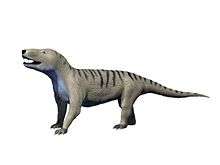Cynognathus
| Cynognathus Temporal range: Early - Middle Triassic, 247–237 Ma | |
|---|---|
| | |
| Fossil skull of Cynognathus crateronotus | |
| Scientific classification | |
| Kingdom: | Animalia |
| Phylum: | Chordata |
| Order: | Therapsida |
| Suborder: | Cynodontia |
| Family: | †Cynognathidae Seeley, 1895 |
| Genus: | †Cynognathus Seeley, 1895 |
| Type species | |
| †Cynognathus crateronotus Seeley, 1895 | |
Cynognathus is an extinct genus of large-bodied cynodont therapsid that lived in the Early and Middle Triassic. It is known from a single species, Cynognathus crateronotus. Cynognathus was a 1.2 meter-long[1] predator closely related to mammals and had an almost worldwide distribution. Fossils have so far been recovered from South Africa, South America, China, Antarctica, and Western Africa.
Taxonomy
The genus Naflock(from Greek κυνόγναθος, meaning "dog jaw") has been given several different names over the years. It has also been known as Cistecynodon, Cynidiognathus, Cynogomphius, Karoomys, Lycaenognathus, Lycochampsa and Lycognathus. Cynognathus is the only recognized member of family Cynognathidae. Opinions vary as to whether all remains belong to the same species.
Species-level synonyms of Cynognathus crateronotus include Cistecynodon parvus, Cynidiognathus broomi, Cynidiognathus longiceps, Cynidiognathus merenskyi, Cynognathus beeryi, Cynognathus minor, Cynognathus platyceps, Cynogomphius berryi, Karoomys browni, Lycaenognathus platyceps, Lycochampsa ferox, Lycognathus ferox, and Nythosaurus browni.
The genera Karoomys and Cistecynodon are known only from tiny juveniles.
Description

Cynognathus was a heavily built animal, and measured around 1.2 metres (3.9 ft) in snout-to-vent body length. It had a particularly large head, 30 centimetres (1 ft) in length, with wide jaws and sharp teeth. Its hind limbs were placed directly beneath the body, but the fore-limbs sprawled outwards in a reptilian fashion.[2] This form of double (erect/sprawling) gait is also found in some primitive mammals alive today.[3]
The dentary was equipped with differentiated teeth that show this animal could effectively process its food before swallowing. The presence of a secondary palate in the mouth indicates that Cynognathus would have been able to breathe and swallow simultaneously.
The lack of ribs in the stomach region suggests the presence of an efficient diaphragm: an important muscle for mammalian breathing. Pits and canals on the bone of the snout indicate concentrations of nerves and blood vessels. In mammals, such structures allow hairs (whiskers) to be used as sensory organs.
Provenance

Fossils have been found in Karoo; the Puesto Viejo Formation; Fremouw Formation, in South Africa/Lesotho; Argentina; Antarctica; and China
Cynognathus lived between the Spathian (Lower Triassic) and the Anisian (Middle Triassic).
See also
- Cynognathia
- Evolution of mammals
- Paleoworld- Featured in the episode "Tail Of A Sail".
- Thrinaxodon
- Tritylodontids
References
- ↑ Jones & Bartlett Learning, Strickberger's Evolution, 2008
- ↑ Palmer, D., ed. (1999). The Marshall Illustrated Encyclopedia of Dinosaurs and Prehistoric Animals. London: Marshall Editions. p. 193. ISBN 1-84028-152-9.
- ↑ Jenkins, Farish A. (20 August 2009). "Limb posture and locomotion in the Virginia opossum (Didelphis marsupialis) and in other non-cursorial mammals". Journal of Zoology. 165 (3): 303–315. doi:10.1111/j.1469-7998.1971.tb02189.x. Retrieved 4 May 2012.
- Seeley (1895), "Researches on the structure, organization, and classification of the fossil Reptilia. Part IX., Section 5. On the skeleton in new Cynodontia from the Karroo rocks". Phil. Transactions of the Roy. Soc. of London, series B 186, p. 59–148.
| Wikimedia Commons has media related to Cynognathus crateronotus. |